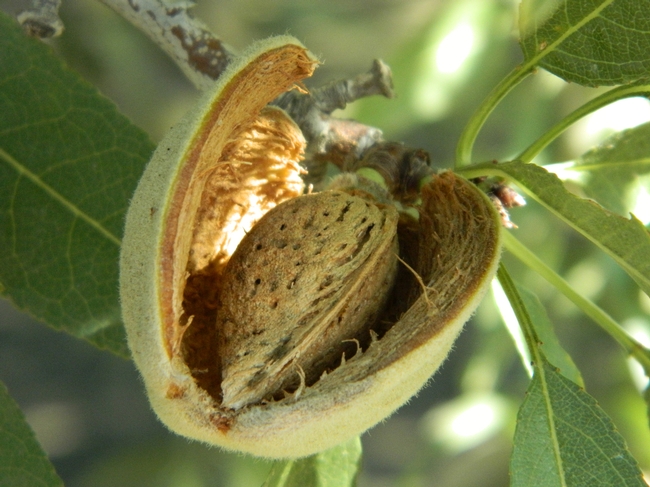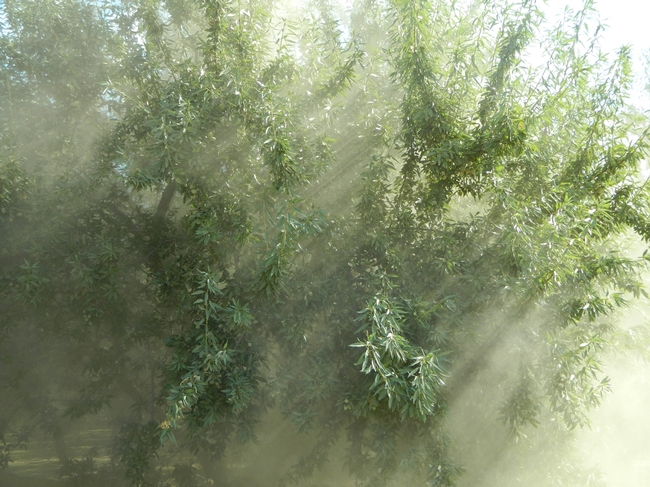Enjoy your tree nuts: UC scientists help with regulatory compliance
California tree nut growers will soon have to comply with new agriculture water testing requirements under the Produce Safety Rule in the 2011 Food Safety Modernization Act (FSMA). University of California researchers and advisors are holding seminars to share information about the agricultural water requirements and proper water sampling methods in order to be in compliance with the regulations.
While irrigation or spray water is generally not the source of contamination, it is a vehicle for pathogens that are harmful to humans, especially on produce that is consumed raw; therefore, agricultural water was included as a part of the new regulation.
The UC Cooperative Extension office in Yolo County was the site of the first information sessions for nut tree growers/producers. It was an ideal location, as the fertile soils of the Sacramento and San Joaquin valleys are home to the largest tree nut production industries in the U.S. Some nuts are also grown in the coastal valley regions and Sierra foothills.
Good news for nut consumers
The new regulations and the focus on food safety practices, particularly within the nut tree industry, is of great interest because of the popularity of nutritious and delicious tree nuts. I for one am a big consumer. My day starts with almond butter on toast. That's followed by snacks of raw walnuts and dates. And there's always the handful of roasted pistachios to be grabbed for a salty treat.
It is lucky for someone who is nuts about nuts to live in California. The state is the nation's No. 1 walnut, almond and pistachio producer. California produces 80 percent of the world's almonds. We produce one million tons of almonds each year, followed by walnuts at nearly half a million tons, and pistachios at over a quarter million tons.
The California Department of Food and Agriculture reports the state's leading agricultural export products by value in 2015 were almonds ($5.14 billion), dairy products ($1.63 billion), walnuts ($1.49 billion), wine ($1.48 billion), and pistachios ($848 million).
Melissa L. Partyka, an ecologist at the UC Davis Western Institute for Food Safety and Security, (WIFSS) and Ronald F. Bond, a water quality researcher and field coordinator with WIFSS, are engaging local growers on issues of food safety and helping to educate them on not only the regulations but on ways to improve their water quality.
Partyka and Bond are staff in the UC Agriculture and Natural Resources' Vet Med Extension and Atwill Water and Foodborne Zoonotic Disease Laboratory, headed by UC Cooperative Extension specialist Rob Atwill, director of WIFSS.
They are affiliated with the Western Center for Food Safety, a Food and Drug Administration Center of Excellence, and are helping break down the regulations for the growers, regulations which can be a little overwhelming to the untrained.
Agricultural water, according to FSMA, is that water used to irrigate, treat, harvest, wash commodity or equipment on farm.
Growers are required to test water if it:
- Comes in contact with the harvestable portion of the commodity
- Is used to clean harvest equipment
- Is used to mix pesticides/fungicides applied to commodity
- Is used by harvest crews to wash hands
As of January 2016 growers will have 2 to 4 years (depending on farm size) to comply with most aspects of the Produce Safety Rule. Basically, the larger the production, the higher potential for risk to the consumer. How often a grower samples water depends on the water source. Well water requires an initial four samples, followed by one sample per year. Surface water, requires an initial 20 samples, followed by five samples per year. Water samples should be collected as close to harvest as is practical. During a long harvest season, samples can be spread out; in short harvest seasons, samples should be collected closer together; and in multiple harvest seasons, samples should be taken near each harvest if water is coming from the same source.
A full day workshop to be hosted by UC Cooperative Extension is planned for late June. Look for announcement of date, time, and location on the following websites: www.wcfs.ucdavis.edu, http://ucanr.edu, www.wifss.ucdavis.edu.
Comments:
FSMA regulations aim to ensure the U.S. food supply is safe by shifting the focus from responding to contamination to preventing it. The workshops serve to raise awareness of the FSMA Produce Safety Rule. There’s always potential for contamination through the pre and post-harvest continuum but the new standards reduce the possibility of contamination of food products from the farm to the consumer – including raw nuts. This is good news for the consumer.
Feel free to come to a future workshop or e-mail the researchers directly.
Chris Brunner
Can dairy waste water be discharged on to almond or pistachio trees?
I'm currently looking at this link : https://www.waterboards.ca.gov/centralvalley/board_decisions/adopted_orders/general_orders/r5-2013-0122.pdf
"Land Application Specifications 21"
E. LAND APPLICATION SPECIFICATIONS 1. Wastes and land application areas shall be managed to prevent contamination of crops grown for human consumption. The term “crops grown for human consumption” refers only to crops that will not undergo subsequent processing which adequately removes potential microbial danger to consumers.
I wanted to know the exact specifications in regards to almond or pistachio trees.
I appreciate your help with this matter.



are these foods
Posted by Jack Sanders on March 15, 2017 at 8:41 AM